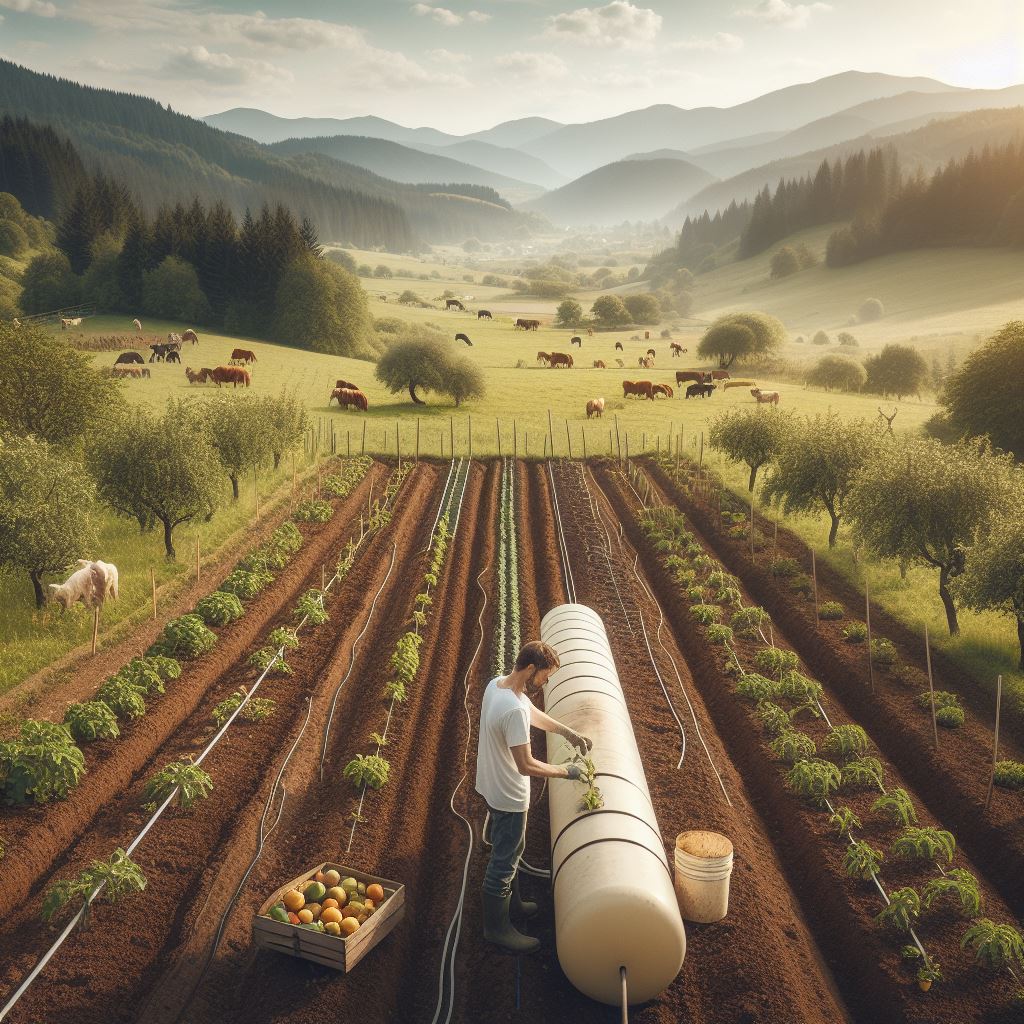Permaculture Zones: Effective Planning
Last Updated on March 4, 2024
Introduction
Permaculture is a design approach that aims to create sustainable and self-sufficient systems by mimicking natural ecosystems.
Effective planning is essential in permaculture as it enables the efficient use of resources and maximizes yields.
By strategically organizing and designing permaculture zones, the different functions and elements within a system can be optimized.
Permaculture zones are areas within a design that are organized based on their uses and resources.
Zero zone is the central hub, typically the home, where intensive activities and daily needs are fulfilled.
First zone is located close to zone 0 and consists of high-intensity elements like vegetable gardens, small livestock, and small-scale composting.
Second zone contains larger scale garden plots, orchards, and medium-sized livestock.
Third zone is further away and can include larger livestock, grain crops, and more extensive orchards.
Fourth zone consists of wild plants and animals, while zone 5 is left untouched and serves as a place for wildlife preservation.
Effective planning through permaculture zones places elements needing frequent attention strategically near the home, minimizing effort and time.
It also helps in identifying appropriate locations for specific functions, depending on factors like sun exposure, soil quality, and water availability.
In summary, permaculture emphasizes effective planning to create sustainable and self-sufficient systems.
The concept of permaculture zones aids in organizing and optimizing different elements within a design, maximizing efficiency and productivity.
Understanding Permaculture Zones
Permaculture zones are a strategic approach to land planning and design that optimize efficiency and sustainability.
They involve dividing an area into different zones based on their proximity to the central living space or key activities.
This helps to minimize energy and resource use while maximizing productivity and yield.
Definition of permaculture zones
Permaculture zones are a concept developed by Australian ecologist Bill Mollison.
They are a key element of permaculture design and involve dividing a site into different areas based on their functions and accessibility.
Purpose of dividing an area into zones
The main purpose of dividing an area into zones is to create a systematic and efficient design that maximizes productivity and minimizes the need for energy inputs.
By placing elements closer to the central living space or key activities, they become more easily accessible.
Benefits of permaculture zones
- Increased efficiency: By organizing elements in zones, it becomes easier to manage and maintain the site. This saves time and effort.
- Reduced energy use: Zones allow for a more localized approach, reducing the need for excessive energy inputs such as transportation or water pumping.
- Improved productivity: By placing the most intensively used elements closer to the living space, it becomes easier to manage and harvest yields, leading to higher productivity.
- Enhanced biodiversity: Zones enable the design of habitats that support diverse flora and fauna, promoting ecological balance and resilience.
- Improved self-sufficiency: Permaculture zones facilitate the production of food, energy, and other resources closer to where they are needed, increasing self-reliance.
- Effective land use: Zones help optimize land use by assigning appropriate functions based on the specific characteristics and needs of each area.
- Reduced waste: By strategically placing waste-producing elements closer to areas where they can be reused or recycled, permaculture zones minimize waste.
By understanding permaculture zones and their role in design, individuals can create more sustainable landscapes that function efficiently and provide abundant yields with fewer inputs.
Read: Urban Beekeeping: Buzzing to Sustainability
The Principle of Zoning
Explanation of how to effectively plan permaculture zones
Organizing a permaculture design into different zones allows for efficient energy and resource use.
Strategically placing elements according to their needs saves resources and maximizes productivity.
Factors to consider when designing permaculture zones
- Sunlight and shade patterns: When planning permaculture zones, it’s crucial to assess the patterns of sunlight and shade. This includes noting where shadows fall at different times of the day and throughout the seasons. By understanding these patterns, specific plants can be placed strategically to optimize their growth potential.
- Water availability and drainage: Water availability and drainage are integral to successful permaculture zone planning. Analyzing the natural water sources on the site and ensuring proper drainage helps avoid water logging or drought within the zones. It’s important to design zones that capture and store rainwater, allowing for sustainable irrigation and reducing the need for external water sources.
- Soil characteristics and fertility: Understanding soil characteristics and fertility informs the selection of appropriate plants for each specific zone. By analyzing soil composition, pH levels, and nutrient content, gardeners can choose crops that thrive in those conditions, reducing the need for excessive soil amendments or fertilizers.
- Access and human activity: Considering access and human activity is another vital aspect of permaculture zone planning. Placing frequently visited elements, such as herb gardens or compost bins, closer to the house reduces the time and effort required for maintenance tasks. Strategically locating zones concentrates and minimizes human activity in specific areas, preserving the relative undisturbed nature of others.
Examples of successful permaculture zone planning
- Successful permaculture zone planning involves observing and learning from existing models.
- Examples of well-designed permaculture zones can be found worldwide, such as the permaculture farm at Zaytuna Farm in Australia.
- The farm showcases the integration of animals, food forests, and water harvesting systems within their zoning strategies, resulting in a highly productive and sustainable system.
In short, effective planning of permaculture zones requires careful consideration of factors such as sunlight, water, soil, and human activity.
By organizing elements into different zones, perma culturists can design systems that optimize resource use, minimize maintenance efforts, and promote sustainable productivity.
Through studying successful examples, permaculture practitioners can continually improve their own zone planning strategies.
Read: Water Wise: Urban Farming Irrigation Tips
Different Permaculture Zones
Permaculture zones are a vital part of effective planning as they help organize and optimize resources on a property.
By dividing the landscape into different zones, we can create efficient and sustainable systems that work in harmony with nature.
Zero Zone: The Home
- Zone 0’s characteristics and purpose: Zone 0, which is the area closest to the home, includes the house itself and its immediate surroundings. Zone 0 is the center of human activity, where we spend most of our time.
- Examples of activities in Zone 0: It encompasses activities such as cooking, cleaning, and personal hygiene. This zone serves as the hub of our daily lives.
First Zone: Intensive Production
- Zone 1’s characteristics and purpose: Moving outwards, we enter Zone 1. This zone is characterized by intensive production that requires regular attention and maintenance. Zone 1 allows us to establish a close connection between the home and the food we consume.
- Examples of appropriate plantings and activities in Zone 1: It is located closest to Zone 0 and includes elements such as vegetable gardens and fruit trees that we frequently interact with.
Second Zone: Semi-Intensive Production
- Zone 2’s characteristics and purpose: Zone 2, which extends further away from Zone 0, is designated for semi-intensive production. Zone 2 requires less regular attention compared to Zone 1 but still plays a significant role in providing food and resources for the household.
- Examples of appropriate plantings and activities in Zone 2: Suitable plantings in Zone 2 include fruit trees, berries, and small livestock.
Third Zone: Extensive Agriculture
- Zone 3’s characteristics and purpose: As we venture even further from Zone 0, we enter Zone 3. Here, extensive agriculture takes place, involving crops that require minimal maintenance. This zone is essential for long-term food production and sustainability.
- Examples of appropriate plantings and activities in Zone 3: Zone 3 includes grains, larger orchards, and rotational pasture grazing
Fourth Zone: Managed Wilderness
- Zone 4’s characteristics and purpose: Moving towards the outer edges of the property, we encounter Zone 4. Zone 4 serves as a managed wilderness area where some natural elements and wildlife can coexist alongside humans. Zone 4 offers a balance between human intervention and preservation of natural systems.
- Examples of appropriate plantings and activities in Zone 4: Tree plantations, managed woodland, and wild foraging are examples of activities in Zone 4.
Fifth Zone: Natural Wilderness
- Zone 5’s characteristics and purpose: Lastly, Zone 5 is the natural wilderness area, left completely untouched by human activity. This zone serves as a sanctuary for wildlife and natural ecosystems. This zone allows us to observe and appreciate the beauty and diversity of nature without disrupting its delicate balance.
- Examples of appropriate plantings and activities in Zone 5: In Zone 5, activities are limited, and plantings are native species that don’t require human intervention.
By understanding and effectively utilizing the different permaculture zones, we can create a harmonious and sustainable living environment.
Each zone has its own characteristics and purpose, ranging from high human activity to minimal intervention.
Through thoughtful planning and utilization, permaculture zones enable us to live in harmony with nature while meeting our needs and conserving resources for future generations.
Read: Indoor Farming: Techniques and Benefits

Tips for Effective Planning of Permaculture Zones
Assess site conditions before creating zones
- Survey the land to determine its characteristics and limitations.
- Analyze the soil quality, water availability, and sun exposure.
- Identify any existing structures or natural features that could impact zone placement.
- Consider the climate and microclimates within the site.
- Take into account any potential hazards or risks, such as flooding or strong winds.
Use the principle of relative location for zone placement
- Place zones closer to the areas that require more frequent visits and management.
- Create a hierarchical order based on the intensity of human activity and resource needs.
- Design zones in a way that minimizes energy and time spent on maintenance and travel.
- Consider the natural flow of people, water, and resources within the site.
- Ensure that zones are easily accessible and convenient to work with.
Regular observation and adjustment of permaculture zones
- Continuously monitor the performance and efficiency of each zone.
- Observe interactions between plants, animals, and natural elements in each zone.
- Note any changes or challenges that may arise over time.
- Periodically reassess the needs and functions of each zone.
- Make adjustments in order to optimize productivity and sustainability.
Consider future plans and potential changes in the landscape
- Anticipate and plan for possible expansion or contraction of the site in the future.
- Account for any upcoming construction or development projects.
- Think about potential changes in climate patterns or weather conditions.
- Consider changes in personal circumstances or goals that may affect the site.
- Create flexible zones that can adapt to future changes and allow for easy modifications.
In a nutshell, effective planning of permaculture zones requires careful assessment of site conditions, thoughtful placement based on relative location, regular observation and adjustment, and consideration of future plans and potential changes.
By following these tips, permaculture practitioners can optimize the productivity and sustainability of their sites while minimizing time and energy spent on maintenance.
Read: Urban Composting: Turning Waste to Gold
Discover More: Organic Certification: Process and Benefits
Conclusion
Permaculture zones are vital in effective planning, offering a strategic blueprint for sustainable land use.
Implementing these zones ensures thoughtful design, maximizing efficiency and harmony in agricultural systems.
Embrace permaculture zones to create resilient, thriving ecosystems. In designing your permaculture zones, consider the unique needs of each area, fostering a holistic approach.
Successful permaculture zone design integrates functionality, accessibility, and sustainability, harmonizing human activities with the natural environment.
Cultivate a landscape where every zone plays a purposeful role, contributing to the overall resilience and productivity of the permaculture design.


